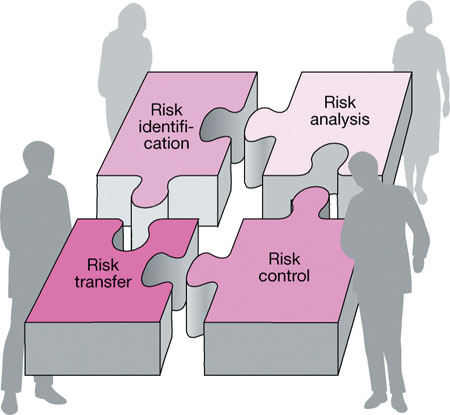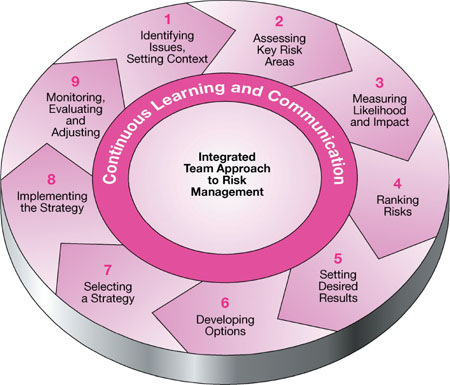Chapter 2
Principles of Risk Management
Risk management is a relatively young discipline. Its principles are rooted in the mathematics of probability and the logical constructs of decision-making amidst uncertainty. The threats of litigation, the so-called complaints culture, negative media coverage have all become increasingly common in dentistry in recent years, and have forced the hand of risk management for dentists.
Risk management is considered by the Medical Protection Society to be “understanding the risks of clinical practice – and overcoming them in a planned (and) positive way”. We can define it as the systematic approach to setting the best course of action under the burden of uncertainty by identifying, assessing, understanding, acting on and communicating risk issues.
Core Principles
The key points of risk management to bear in mind are:
-
It is directed at uncertainty related to future events and outcomes, which implies that all planning exercises encompass some form of risk management.
-
It should be a practice-wide activity and an integral part of everyday practice management.
-
It should be a continuous and proactive process – this ensures that less time is spent reacting to situations and more time is spent taking advantage of opportunities.
-
It should inform effective decision-making.
-
It is the responsibility of the dental team, since all individuals at clinical and non-clinical levels can provide some insight into the nature, likelihood and impacts of risk.
Many writers have endorsed these observations. In an article in the Journal of the American Dental Association (June 2002), Graskemper stated: “Risk management in dentistry has been developed over the years by concentrating on recording treatment in dental records and informing patients of the proposed treatment before treating them.” The author identified the purpose of his article as an attempt to: “Advance the concept of risk management through higher involvement of the entire office staff by increasing communication with patients.”
He concluded: “By integrating practice management concepts with risk management techniques, dentists can reduce risk management exposure and improve patients’ awareness, understanding and follow-through on the treatment of their dental needs.”
The benefits of risk management are:
-
improved patient care
-
a reduction in risk exposure
-
a closer working relationship between the dental team
-
improved patient acceptance of proposed treatment
-
growth in demand of services.
We are better able to respond to risk in general practice if:
-
there are clinical and management protocols in place
-
the prevailing attitude is one of experiential learning – the team are willing and able to learn from past experiences
-
the practice is patient-centred
-
the focus is on the present and future – neither should be compromised for the other.
To achieve these objectives strong leadership skills and team involvement are essential.
Aims of Risk Management
The purpose of risk management is to:
-
assess continuously what could go wrong (risks)
-
determine which risks are important to deal with
-
implement strategies to deal with those risks.
It is the sum of all proactive activities within the practice that are intended acceptably to accommodate the possibility of failures in clinical and non-clinical care which result in sub-optimal outcomes. In this context it is important to remember that the interpretation of acceptably is as judged by the patient, the peer group, professional associations and regulatory bodies.
In the past, risk management was a reactive exercise; the evaluation report after an incident had taken place (firefighting and crisis management). Today’s society demands a more proactive approach that avoids problems before they arise.
Anticipating what might go wrong should become a part of everyday professional practice, and the management of risks should be a part of day-today practice management. We should invoke the precautionary principle so that problems are prevented before they occur.
The cost of a laissez-faire attitude is high. Litigation costs for the NHS are reported to be approaching £380 million per annum and rising. The true costs are higher still when we take into account the human costs which may include physical harm, emotional trauma, a variety of stress-related conditions and damaged reputations.
Like it or not, it is inevitable that risk management generates paper trails; documentation is an important part of the process. It demonstrates our understanding and application of relevant legislation, regulations and evidence-based practice. Without this trail it is difficult to convince outside parties – patients and regulatory bodies – that we have the necessary processes in place. Absence of documentation amounts to absence of evidence, which makes any particular allegation very difficult if not impossible to defend. The inference is that if it is not on paper it didn’t or doesn’t happen.
The Risk Management Cycle
The simplest model of risk management contains four elements (Fig 2-1):
-
Risk identification – what can go wrong?
-
Risk analysis – what are the chances of it going wrong and what are the consequences?
-
Risk control – what can be done about the risk?
-
Risk transfer – we can either assume the risk or transfer the potential losses to a third party.

Fig 2-1 The basic principles of risk management.
These principles can be expanded into nine processes which make up the risk management cycle (Fig 2-2).

Fig 2-2 The expanded risk management cycle.
In Australia and New Zealand the official approved standard for risk management is a five-step process, which reflects the same basic principles:
-
establish the context (strategic, organisational, managerial)
-
identify the risks
-
analyse the risks
-
assess and prioritise the risks
-
treat (manage) the risks.
Risk Identification
The purpose of risk identification is to capture all the significant risks that may affect dentists in clinical practice. These risks can be identified under broad categories, including:
-
Clinical risk – the risk that clinical decision-making is deficient with the result that the treatment provided will not bring about the desired outcomes.
-
Operational risk – the risk that the practice policies may be deficient in some way with the result that they will not deliver the desired outcome for the practice as a business.
-
Business risk – the risk that deficiencies in cost control or revenue generation will adversely affect the business performance of the practice (see Chapter 10).
-
Reputation risk – the risk that a loss of confidence in the practice by patients could impair its progress by causing a downturn in patient demand (see Chapter 10).
Risk Analysis and Assessment
Risk assessment is present in the everyday life of every person. We all perform risk assessments in one form or another, sometimes without even realising it. We ask ourselves, for example:
-
/>
Stay updated, free dental videos. Join our Telegram channel

VIDEdental - Online dental courses


